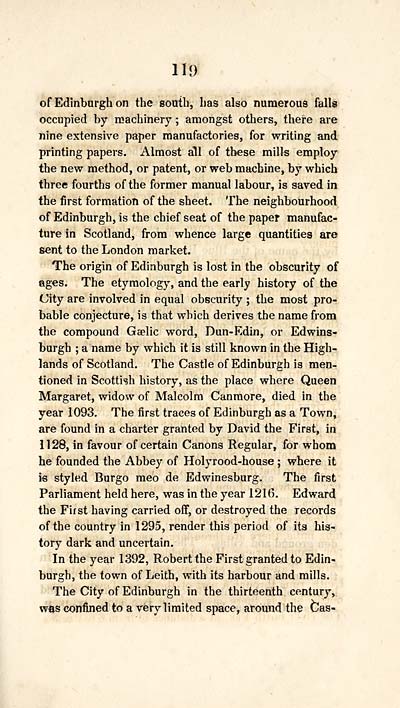Descriptive account of the principal towns in Scotland
(141) Page 119
Download files
Complete book:
Individual page:
Thumbnail gallery: Grid view | List view

119
of Edinburgh on the south, has also numerous falls
occupied by machinery ; amongst others, there are
nine extensive paper manufactories, for writing and
printing papers. Almost all of these mills employ
the new method, or patent, or web machine, by which
three fourths of the former manual labour, is saved in
the first formation of the sheet. The neighbourhood
of Edinburgh, is the chief seat of the paper manufac-
ture in Scotland, from whence large quantities are
sent to the London market.
The origin of Edinburgh is lost in the obscurity of
ages. The etymology, and the early history of the
City are involved in equal obscurity ; the most pro-
bable conjecture, is that which derives the name from
the compound Gaelic word, Dun-Edin, or Edwins-
burgh ; a name by which it is still known in the High-
lands of Scotland. The Castle of Edinburgh is men-
tioned in Scottish history, as the place where Queen
Margaret, widow of Malcolm Canmore, died in the
year 1093. The first traces of Edinburgh as a Town,
are found in a charter granted by David the First, in
1128, in favour of certain Canons Regular, for whom
he founded the Abbey of Holyrood-house ; where it
is styled Burgo meo de Edwinesburg. The first
Parliament held here, was in the year 1216. Edward
the First having carried off, or destroyed the records
of the country in 1295, render this period of its his-
tory dark and uncertain.
In the year 1392, Robert the First granted to Edin-
burgh, the town of Leith, with its harbour and mills.
The City of Edinburgh in the thirteenth century,
was confined to a very limited space, around the Cas-
of Edinburgh on the south, has also numerous falls
occupied by machinery ; amongst others, there are
nine extensive paper manufactories, for writing and
printing papers. Almost all of these mills employ
the new method, or patent, or web machine, by which
three fourths of the former manual labour, is saved in
the first formation of the sheet. The neighbourhood
of Edinburgh, is the chief seat of the paper manufac-
ture in Scotland, from whence large quantities are
sent to the London market.
The origin of Edinburgh is lost in the obscurity of
ages. The etymology, and the early history of the
City are involved in equal obscurity ; the most pro-
bable conjecture, is that which derives the name from
the compound Gaelic word, Dun-Edin, or Edwins-
burgh ; a name by which it is still known in the High-
lands of Scotland. The Castle of Edinburgh is men-
tioned in Scottish history, as the place where Queen
Margaret, widow of Malcolm Canmore, died in the
year 1093. The first traces of Edinburgh as a Town,
are found in a charter granted by David the First, in
1128, in favour of certain Canons Regular, for whom
he founded the Abbey of Holyrood-house ; where it
is styled Burgo meo de Edwinesburg. The first
Parliament held here, was in the year 1216. Edward
the First having carried off, or destroyed the records
of the country in 1295, render this period of its his-
tory dark and uncertain.
In the year 1392, Robert the First granted to Edin-
burgh, the town of Leith, with its harbour and mills.
The City of Edinburgh in the thirteenth century,
was confined to a very limited space, around the Cas-
Set display mode to: Large image | Transcription
Images and transcriptions on this page, including medium image downloads, may be used under the Creative Commons Attribution 4.0 International Licence unless otherwise stated. ![]()
| Gazetteers of Scotland, 1803-1901 > Descriptive account of the principal towns in Scotland > (141) Page 119 |
|---|
| Permanent URL | https://digital.nls.uk/97352397 |
|---|

